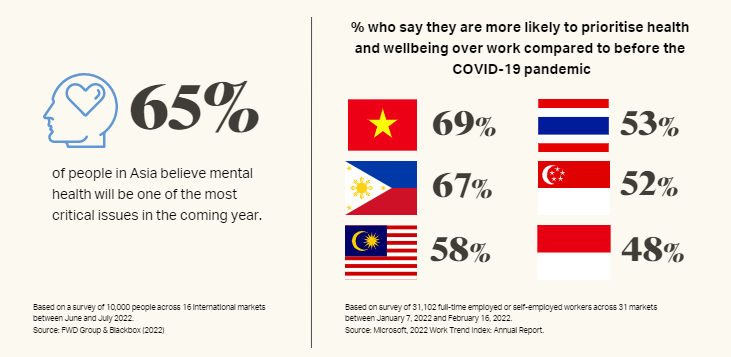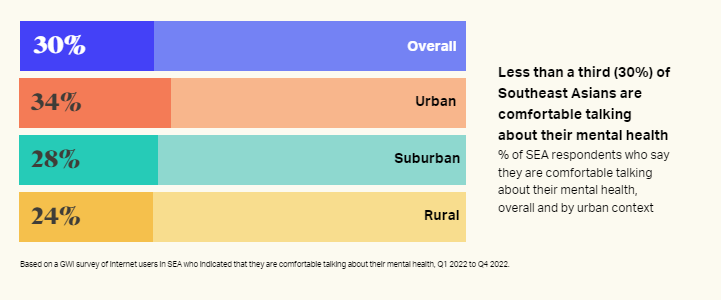Spotlight SEA explores changing notions of wellbeing in Asia as an outlet for alleviating consumer anxiety and WARC’s Stephanie Siew deep dives into key insights from this Spotlight Infographic, with data provided by GWI and supported by knowledge and opinion from industry experts.
This article is part of a Spotlight series on consumer anxiety and mental health in Asia. Read more
Navigating one crisis after another can feel overwhelming, especially when people are still recovering from the psychological stress and social isolation brought on by the pandemic. Faced with these pressures, it is unsurprising that nearly two-thirds (65%) of Asians believe mental health will be one of the most critical issues in the coming year.
But what Southeast Asians are grappling with has changed
Three years after the onset of COVID-19, pandemic-related health concerns are starting to lose their grip on people’s minds. Today, Southeast Asians have other worries to grapple with. Data from WARC’s latest Spotlight SEA infographic shows that unemployment and economic recession, climate change, widening socioeconomic gaps, and increased military tensions are some of the most pressing challenges this year.
Recognition of issues surrounding anxiety and stress is growing in the workplace too. SEA has historically faced high levels of burnout and poor quality of life at work. Post-COVID, approximately half or more of employees in SEA say they are more likely to prioritise health and well-being over work compared to before the pandemic. This sentiment is led by Vietnam (69%), the Philippines (67%) and Malaysia (58%).

Despite the increasing attention around mental health issues, many are suffering in silence
Mental health stigma continues to be a significant challenge in the region, preventing people from opening up and seeking help. GWI data shows that less than a third (30%) of Southeast Asians are comfortable talking about their mental health.
This number drops to 24% among people living in rural areas, compared to 34% of those in urban contexts, potentially reflecting the different levels of awareness and acceptance in these communities.

Stigma around this topic is difficult to overcome, especially when it stems from generations of deeply rooted cultural beliefs and values. In highly collectivistic Asian cultures, there is a strong desire to “save face” and mental health struggles are often seen as a weakness that can bring shame to the family.
These beliefs are so ingrained in the culture that it is reflected in the language. One study of Singaporean youths found that nearly half (45%) of them associate mental illness with derogatory terms such as “dangerous”, “crazy” and “weird”.
Addressing consumer anxiety and doing away with social stigma
Like other parts of the world, SEA today has myriad reasons to feel worried. While there’s been greater awareness and prioritisation of mental health in the region, widespread social stigma means it is often treated as a lonely, personal struggle.
Rather than skirting the issue, brands must take a nuanced approach and consider the cultural context to understand the biggest concerns on consumers’ minds and the barriers they face in addressing them.
To find out more, read our SEA Spotlight infographic here.
Read more in this Spotlight series
Under pressure: How can brands better understand Asian consumer anxiety?
Rica Facundo
WARC
How Calm Collective is making mental wellbeing more accessible in Asia
Alyssa Reinoso
Calm Collective
How AXA is a “partner” and not a “preacher” to make “mind health” more accessible in Asia
Sabrina Cheung
AXA
In an age of permacrisis, design for a new care economy in SEA
Brian Chien, Grace Gandi Goesantoso and Mun Yee
Accenture Song
Anxiety in the age of permacrisis: How brands can help to reduce it for Asian consumers
Maz Amirahmadi
Human8
Diplomas yesterday, diapers today: What brands can learn from what makes Gen Z parents in Singapore anxious
Frederick Tong and Sathya Krishnan
Ogilvy
Online communities and the social battery: Alleviating Gen Z anxieties in Asia
Abhimanyu Kumta
Quantum

